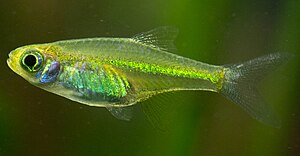Microdevario kubotai
| Microdevario kubotai | ||||||||||||
|---|---|---|---|---|---|---|---|---|---|---|---|---|

Microdevario kubotai |
||||||||||||
| Systematics | ||||||||||||
|
||||||||||||
| Scientific name | ||||||||||||
| Microdevario kubotai | ||||||||||||
| ( Kottelat & Witte, 1999) |
Microdevario kubotai ( synonym Microrasbora kubotai ) in the aquarium as Emerald Zwergrasbora or Neon green Zwergbärbling known, is a very small freshwater fish of the subfamily of danios (Danioninae). He comes in the Thai portion of the Malay Peninsula of Ranong in the north to Phang-nga in the south, in the basin of the Ataran Burmese Kayin State and probably also in the area between rivers and streams before flowing to the west and in the Andaman Sea lead . In the upper Mae Nam Khwae Noi (Khwae Noi River) the species was introduced by humans. The residential waters have a medium current and are overgrown, which is necessary for spawning.
features
Microdevario kubotai reaches a length of two centimeters and is yellowish to yellowish-green in color with a gold shimmering longitudinal stripe on the sides of the body. The eyes, the gill cover and the belly also shimmer golden. The fins are colorless and transparent. The pectoral fins are sickle-shaped with a very small axillary lobe. The pelvic fins are slightly pointed. A sideline is missing. The tail stalk is 1.6 to 1.9 times longer than it is high.
- Fin formula : dorsal iii / 7, anal iii / 9-10, ventral 7, caudal 10 + 9.
- Dandruff formula : mLr 28-30 + 1-2.
Systematics
The small rasbora was by the Swiss in 1999 ichthyologist Maurice Kottelat and his German colleague Kai-Erik Witte described and named after Katsuma Kubota, a local helper. He was assigned to the genus Microrasbora , which only contains dwarfed danish species. In 2009, the Swedish ichthyologist Sven O. Kullander established the genus Microdevario with M. kubotai as the type species for this and two other bear species . Microdevario differs from Microrasbora in details of the head skeleton .
Danger
Although the Thai population suffers from the fact that the surrounding area of the residential waters is converted into rubber and palm oil plantations and is declining, the species is classified as Least Concern by the World Conservation Union , as most of the total population lives in Myanmar . The development of the population there is not known.
literature
- Maurice Kottelat & Kai-Erik Witte: Two new species of Microrasbora from Thailand and Myanmar, with two new generic names for small Southeast Asian cyprinid fishes (Teleostei: Cyprinidae). Journal of South Asian Natural History, May, 1999, ISSN 1022-0828
Individual evidence
- ↑ Fang, F., M. Norén, T.-Y. Liao, M. Källersjö & SO Kullander 2009: Molecular phylogenetic interrelationships of the south Asian cyprinid genera Danio, Devario and Microrasbora (Teleostei, Cyprinidae, Danioninae). Zoologica scripta v. 38 (no. 3): 237-156. PDF
Web links
- Microdevario kubotai on Fishbase.org (English)
- Microdevario kubotai in the endangered Red List species the IUCN 2012. Posted by: M. Kottelat, 2011. Accessed January 9, 2015.